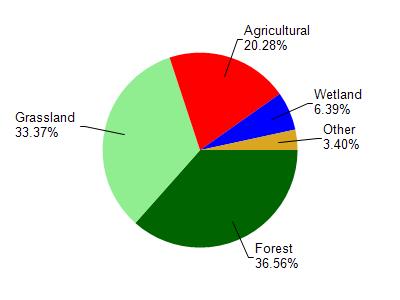Juneau
Yes
No
Yes
Fish and Aquatic Life
Overview
Seymour Creek begins in southeast Monroe County then flows northeast through Vernon County into western Juneau County before reaching the Baraboo River 11.2 miles downstream near Union Center. This stream has a gradient of 15 feet per mile and drains agricultural and forested lands.
Seymour Creek is listed as a Class III trout stream for its entirety in Monroe County and Juneau County. The Vernon County portion of the stream, however, is not a classified trout stream. WDNR stocking records show that brown trout have been stocked in Seymour Creek regularly since 1989. Access to Seymour Creek is from five road crossings.
Date 2002
Author Cynthia Koperski
Historical Description
Seymour Creek, T14N, R1E, Section 12. Surface Acres = 4.4, Miles = 3.6, Gradient = 18.2 feet per mile.
This clear, hard water stream flows in a southeasterly direction through the northeast corner of Vernon County. It joins the Baraboo River in Juneau County. Forage species dominate the fishery. Sand is the dominant bottom type with considerable gravel, some rubble and silt, and small and about equal amounts of boulder, clay, and detritus present. Two road crossings provide access. Muskrat are significant.
From: Klick, Thomas A. and Threinen, C.W., 1973. Lake and Stream Classification Project. Surface Water Resources of Vernon County, Department of Natural Resources, Madison, WI.
Date 1973
Author Surface Water Inventory Of Wisconsin
Impaired Waters
Seymour Creek (WBIC 1291400) was placed on the impaired waters list for total phosphorus in 2014. The portions from Juneau-Vernon county line to the headwaters was assessed during the 2018 listing cycle; new biological (fish Index of Biotic Integrity (IBI) scores) sample data were clearly below the 2018 WisCALM listing thresholds for the Fish and Aquatic Life use. Based on the most updated information, no change in the existing impaired waters listing was needed.
Date 2017
Author Ashley Beranek
Condition
Wisconsin has over 84,000 miles of streams, 15,000 lakes and milllions of acres of wetlands. Assessing the condition of this vast amount of water is challenging. The state's water monitoring program uses a media-based, cross-program approach to analyze water condition. An updated monitoring strategy (2015-2020) is now available. Compliance with Clean Water Act fishable, swimmable standards are located in the Executive Summary of Water Condition in 2018. See also the 'monitoring and projects' tab.
Reports
Recommendations
Restore Wetlands
Restore Wetlands
Management Goals
Wisconsin's Water Quality Standards provide qualitative and quantitative goals for waters that are protective of Fishable, Swimmable conditions [Learn more]. Waters that do not meet water quality standards are considered impaired and restoration actions are planned and carried out until the water is once again fishable and swimmable
Management goals can include creation or implementation of a Total Maximum Daily Load analysis, a Nine Key Element Plan, or other restoration work, education and outreach and more. If specific recommendations exist for this water, they will be displayed below online.
Monitoring
Monitoring the condition of a river, stream, or lake includes gathering physical, chemical, biological, and habitat data. Comprehensive studies often gather all these parameters in great detail, while lighter assessment events will involve sampling physical, chemical and biological data such as macroinvertebrates. Aquatic macroinvertebrates and fish communities integrate watershed or catchment condition, providing great insight into overall ecosystem health. Chemical and habitat parameters tell researchers more about human induced problems including contaminated runoff, point source dischargers, or habitat issues that foster or limit the potential of aquatic communities to thrive in a given area. Wisconsin's Water Monitoring Strategy was recenty updated.
Grants and Management Projects
Monitoring Projects
| WBIC | Official Waterbody Name | Station ID | Station Name | Earliest Fieldwork Date | Latest Fieldwork Date | View Station | View Data |
|---|
| 1291400 | Seymour Creek | 10012187 | Seymour Creek - Upstream Raese Road | 10/13/2004 | 1/1/2015 | Map | Data |
| 1291400 | Seymour Creek | 10011223 | Seymour Creek - Seymour Creek Station #1 (120m Downstream From Raese Rd.) | 1/1/2015 | 1/1/2015 | Map | Data |
| 1291400 | Seymour Creek | 10042981 | Seymour Creek DS of CTH W | | | Map | Data |
|

Watershed Characteristics
Seymour Creek is located in the Seymour Creek and Upper Baraboo River watershed which is 171.73 mi². Land use in the watershed is primarily forest (36.60%), grassland (33.40%) and a mix of agricultural (20.30%) and other uses (9.80%). This watershed has 414.62 stream miles, 124.03 lake acres and 4,637.96 wetland acres.
Nonpoint Source Characteristics
This watershed is ranked Medium for runoff impacts on streams, Not Ranked for runoff impacts on lakes and High for runoff impacts on groundwater and therefore has an overall rank of High. This value can be used in ranking the watershed or individual waterbodies for grant funding under state and county programs.However, all waters are affected by diffuse pollutant sources regardless of initial water quality. Applications for specific runoff projects under state or county grant programs may be pursued. For more information, go to surface water program grants.